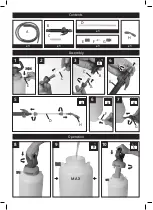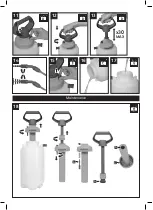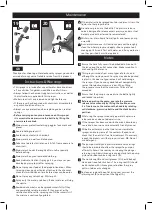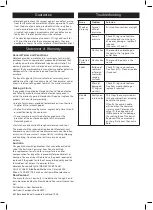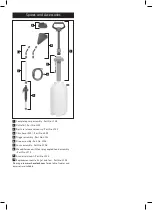
Maintenance
19
I
D
C
B
20
J
A
B
GB
Thank you for choosing a Hozelock quality sprayer, you can be
assured of many years of reliable service from this product.
Instructions & Warnings
• This sprayer is intended for use with water-based solutions
of: insecticides, fungicides, weedkillers and fertilizers.
• Always follow the chemical suppliers instructions, as well as
the instructions supplied with this sprayer.
• Make sure all nuts are screwed hand tight before use.
• If the sprayer has been used with chemicals, discard safely
any unused solution after use.
• Always use eye protection when replacing valves, seals or
springs
• Before carrying out any maintenance on this sprayer
it is essential to depressurize the bottle, by lifting the
pressure release knob.
Always wear protective clothing, goggles, face mask and
gloves.
Avoid inhaling spray mist.
Avoid skin contact with chemicals.
Always work in a well ventilated area.
Take care to protect children, pets & fish from exposure to
chemicals.
Always wash hands thoroughly after use & especially
before eating.
Always wash any contaminated clothing.
Seek medical attention if spray gets in your eyes or you
develop any symptoms after spraying.
Do not spray near food or food preparation areas. When
spraying crops, pay particular attention to the chemical
manufacturers advice on time before crops can be eaten.
Do not spray any solvent e.g. White spirit.
Spray only thin watery solutions; thicker mixtures will clog
the nozzle.
Powdered chemicals can be sprayed successfully if they
are completely soluble in water. If they are not, or the
solution tends to settle, spraying can still be successful if
the mixture is continually agitated.
If the material to be sprayed contains sediment, strain the
liquid into the sprayer bottle.
Do not over pressurize the bottle. The pressure release
valve is designed to release excess pressure, and must not
be tampered with, or forced to remain closed.
Winter use – drain liquid from all parts and loosen pump
assembly.
Annual maintenance – At least once per year thoroughly
clean the whole sprayer and apply silicone grease to all
moving parts & seals. Test with water, and if any washer or
seal has perished it must be replaced.
Notes
A
Ensure the hose fully covers the barbed details on both
the lance, and the outlet connection. Make sure all nuts
are hand tight before use.
B
This sprayer is made from many types of plastic, and
although the liquid you wish to spray may also be packed
in plastic, this does not guarantee it will not damage
the sprayer. If you have any doubt about compatibility,
contact Hozelock consumer services. When filling
the sprayer ensure that the maximum fill level is not
exceeded.
C
Ensure that the pump is screwed into the bottle tightly
and locked in position.
D
Before operating the pump, operate the pressure
release valve manually by lifting the knob to ensure
it is free to move, then release the handle by rotating
anticlockwise, pressurise bottle and then lock back in
position.
E
After using the sprayer, manually operate the pressure
release valve as above, to depressurize.
F
If the sprayer has been used with chemicals discard any
unused solution in an environmentally friendly manner.
G
Fill bottle with warm (not hot) water, reassemble the
sprayer, and spray some of the contents. Repeat, and
check that the nozzle is free from sediment. If necessary,
repeat the process until the sprayer is clean. NB: Do not
use detergent.
H
The pump assembly and pressure release valve o rings
should be lubricated to allow the sprayer to pump air
efficiently. Access the seals by unscrewing the plunger
retaining ring. Apply silicone grease regularly to the pump,
piston and release valve o ring seals (A).
I
The nozzle cap (B) and swirl grooves (C) should be kept
clean and free of obstructions. The o ring seal (D) should
be lubricated with silicone grease to allow the spray
pattern to be easily changed.
J
To clean or replace the outlet o ring seal, unscrew the
retaining nut (B), and pull out the spigot (A).


